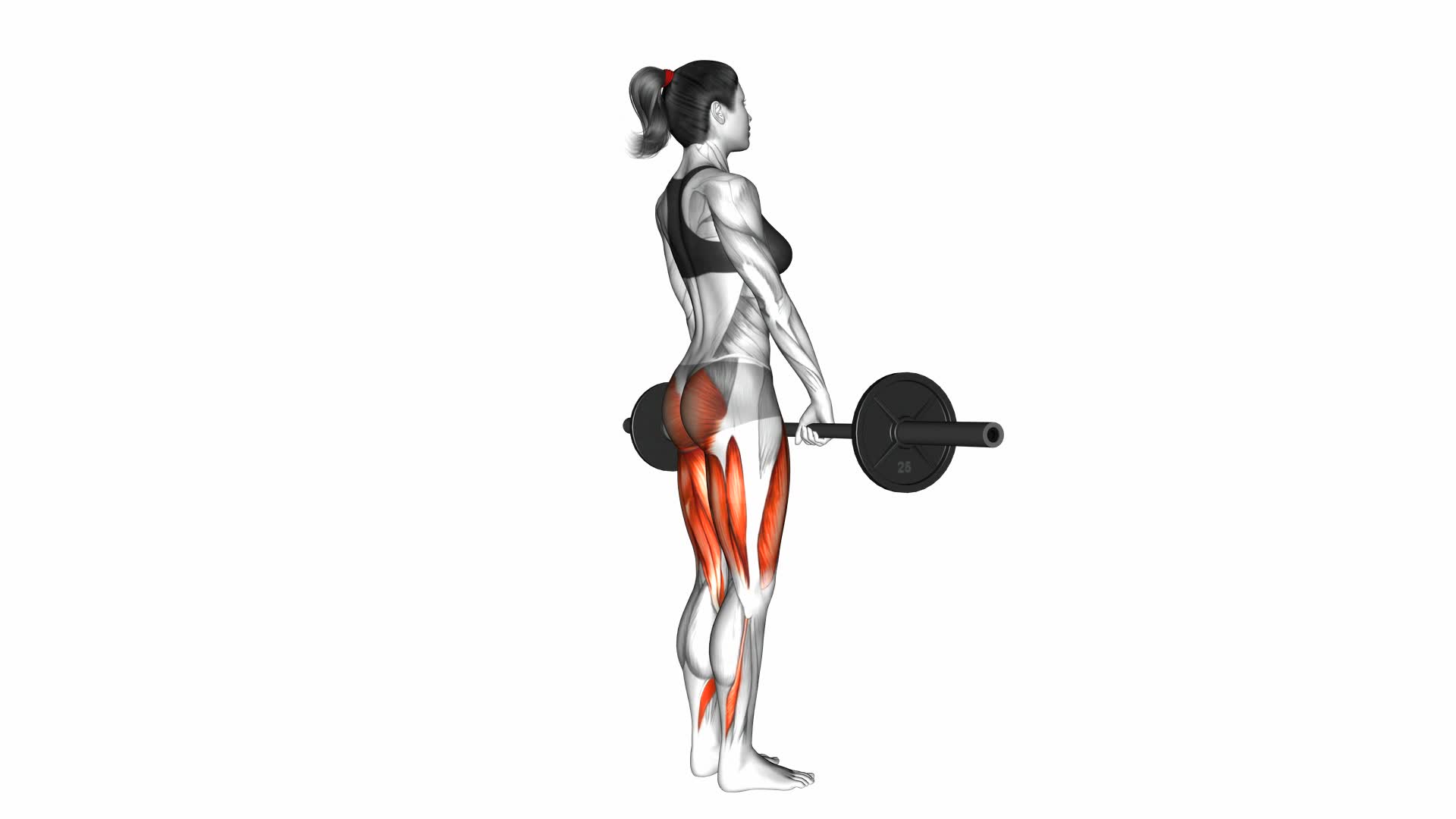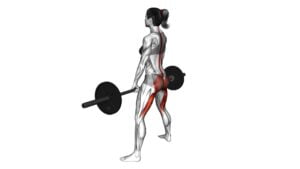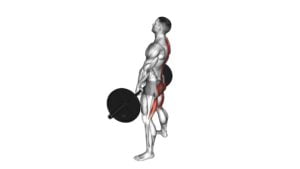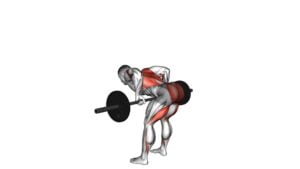Barbell Romanian Deadlift (female) – Video Exercise Guide & Tips

Are you looking for an effective lower body exercise that targets your hamstrings and glutes? Look no further than the Barbell Romanian Deadlift.
Watch This Exercise Video
In this video exercise guide, we'll show you the proper technique and form, as well as common mistakes to avoid.
We'll also provide variations and progressions to challenge yourself.
Incorporate the deadlift into your workout routine and reap the benefits.
Get ready to strengthen and tone your lower body like never before.
Key Takeaways
- Barbell Romanian Deadlift targets the posterior chain and helps strengthen the hamstrings and glutes.
- Proper technique and form, including maintaining a straight back and engaging the core, are essential for performing the exercise correctly.
- Avoid common mistakes such as lifting with a rounded back, using too much weight, and neglecting core engagement.
- Incorporating variations, progressions, and grip techniques can challenge the body in new ways and promote strength gains.
Benefits of the Barbell Romanian Deadlift
One of the top three benefits of performing the barbell Romanian deadlift is that it strengthens your posterior chain, helping you improve your overall athletic performance. This makes it a great exercise for developing strength and stability in the posterior chain.
When comparing the barbell Romanian deadlift to the conventional deadlift, it's important to note that both exercises target different muscle groups. While the conventional deadlift primarily focuses on the lower back, glutes, and hamstrings, the Romanian deadlift places more emphasis on the hamstrings and glutes.
Additionally, when comparing the performance between males and females, it's important to consider individual differences in strength and body composition. While males generally have greater upper body strength, females often have stronger lower body strength. This means that the barbell Romanian deadlift can be an effective exercise for women to build strength in their lower body.
Proper technique and form are crucial when performing the barbell Romanian deadlift. To execute this exercise correctly, start with your feet shoulder-width apart, grip the bar with an overhand grip, and keep your back straight and core engaged throughout the movement. As you lower the barbell towards your shins, focus on hinging at the hips and maintaining a slight bend in your knees. Remember to keep the barbell close to your body and avoid rounding your back.
Proper Technique and Form
To perform the barbell Romanian deadlift with proper technique and form, you should focus on maintaining a straight back, engaging your core, and hinging at the hips while keeping a slight bend in your knees. This exercise primarily targets the hamstrings, glutes, and lower back muscles.
Start by standing with your feet shoulder-width apart and the barbell in front of you on the floor. Bend at the hips, keeping your back straight, and grip the bar with an overhand grip slightly wider than shoulder-width apart. Take a deep breath, brace your core, and lift the barbell by extending your hips and standing up straight.
Keep the barbell close to your body throughout the movement. As you reach the top, squeeze your glutes and pause briefly before slowly lowering the barbell back down by hinging at the hips and maintaining a straight back.
Remember to keep your core engaged and your knees slightly bent throughout the exercise.
Now that you know the proper technique and form for the barbell Romanian deadlift, let's move on to the next section where we'll discuss some common mistakes to avoid.
Common Mistakes to Avoid
To prevent back rounding during the barbell Romanian deadlift, make sure to maintain a neutral spine throughout the movement.
Focus on properly hinging at the hips rather than relying on excessive bending of the knees.
Engage your glutes and hamstrings by squeezing them at the top of the movement to ensure proper muscle activation.
Back Rounding Prevention
Maintain proper spinal alignment during the Barbell Romanian Deadlift to prevent back rounding. Back rounding can lead to injury and decrease the effectiveness of the exercise. Here are some common mistakes to avoid:
- Lifting with a rounded back: Keep your back straight throughout the movement to protect your spine.
- Using too much weight: Gradually increase the weight to ensure you can maintain proper form and prevent rounding.
- Neglecting core engagement: Engage your core muscles to stabilize your spine and prevent rounding.
- Not maintaining a neutral head position: Keep your head in line with your spine to promote proper alignment.
- Rushing the movement: Take your time and focus on maintaining proper form throughout the exercise.
By avoiding these mistakes, you can ensure that you maintain proper spinal alignment and prevent back rounding during the Barbell Romanian Deadlift.
Now, let's transition into the subsequent section about the proper hip hinge technique.
Proper Hip Hinge Technique
To prevent injury and maximize the effectiveness of the Barbell Romanian Deadlift, you need to focus on mastering the proper hip hinge technique.
The hip hinge is a fundamental movement pattern that involves flexing at the hips while maintaining a neutral spine. It's essential for not only the Romanian Deadlift but also for other deadlift variations.
Proper hip hinge technique requires good hip mobility and activation of the posterior chain muscles, including the glutes and hamstrings. Common mistakes to avoid include rounding your back, lifting with your lower back instead of your hips, and not fully engaging your glutes.
Engaging Glutes and Hamstrings
To engage your glutes and hamstrings effectively during the Barbell Romanian Deadlift, it's crucial to avoid these common mistakes:
- Neglecting proper form: Make sure to maintain a neutral spine and engage your core throughout the movement. This will help activate your glutes and hamstrings more effectively.
- Relying solely on lower back: Avoid using your lower back as the primary mover in the exercise. Instead, focus on driving through your heels and squeezing your glutes at the top of the movement.
- Using too much weight: Start with a lighter weight to ensure proper form and activation. Gradually increase the weight as you become more comfortable and confident with the movement.
- Not going through a full range of motion: Make sure to lower the barbell until your hips are fully extended, feeling a stretch in your hamstrings. This will ensure proper activation of both the glutes and hamstrings.
- Rushing the movement: Take your time during each rep to maintain control and focus on engaging the target muscles. Rushing through the exercise can lead to poor form and decreased activation.
Variations and Progressions
To vary your barbell Romanian deadlift routine and continue making progress, you can explore different grip options. Experiment with an overhand grip, an underhand grip, or a mixed grip to target different muscle groups and challenge your body in new ways.
Additionally, as you become stronger, gradually increase the weight you lift to continue progressing and building strength in your posterior chain.
Different Grip Options
Try experimenting with various grip options to enhance your barbell Romanian deadlifts. The way you grip the bar can have a significant impact on your performance and overall strength gains.
Here are five different grip techniques you can try:
- Overhand Grip: This is the most common grip option, where both palms face your body. It helps develop grip strength and is suitable for beginners.
- Mixed Grip: In this grip, one palm faces towards you, while the other faces away. It provides better stability and allows you to lift heavier weights.
- Hook Grip: This grip involves wrapping your thumb around the bar and then gripping it with your fingers. It enhances grip strength and prevents the bar from slipping.
- Fat Gripz Grip: These attachments can be added to the bar to increase its thickness. They challenge your grip strength and forearm muscles.
- Double Overhand Grip: This grip option is similar to the overhand grip, but with both palms facing away from you. It further improves grip strength and forearm development.
By incorporating different grip techniques and grip strength training, you can improve your deadlift performance and achieve better results.
Now, let's move on to the next section and explore how heavier weights can be used for progression.
Heavier Weights for Progression
To progress with heavier weights in the barbell Romanian deadlift, focus on increasing your strength and stability. As you gradually increase the weight, your muscles will adapt and become stronger, resulting in greater strength gains.
Start by gradually adding more weight to the barbell, ensuring that you can maintain proper form and technique throughout the exercise. It's important to challenge yourself without sacrificing form.
As you become more comfortable with the heavier weights, you can also incorporate variations and progressions to continue challenging your muscles and promoting further strength gains. This could include using resistance bands, performing single-leg Romanian deadlifts, or incorporating pauses at different points in the movement.
How to Incorporate the Deadlift Into Your Workout Routine
To incorporate the deadlift into your workout routine, start by choosing a suitable weight and practicing proper form. Deadlifts are a highly effective compound exercise that target multiple muscle groups, including your glutes, hamstrings, and lower back.
Here are five ways to incorporate deadlifts into your routine:
- Start with incorporating deadlifts for beginners: If you're new to deadlifting, begin by using lighter weights and focusing on mastering the correct technique. This will help you build a solid foundation and prevent injuries.
- Gradually increase the weight: As you become more comfortable with the movement, gradually increase the weight to challenge your muscles and promote strength gains.
- Include deadlift variations: Incorporating advanced deadlift variations, such as sumo deadlifts or deficit deadlifts, can target different muscles and add variety to your routine.
- Use deadlifts as a primary lift: Deadlifts can be the centerpiece of your workout, allowing you to prioritize strength and muscle development in the posterior chain.
- Add deadlifts to full-body workouts: If you prefer full-body workouts, include deadlifts as one of the main exercises. This will ensure you engage multiple muscle groups and maximize your overall strength and conditioning.
Safety Precautions and Tips
To ensure your safety and optimize your workout, it's important to follow these safety precautions and tips when performing the barbell Romanian deadlift (female).
Safeguarding yourself during this exercise is crucial to prevent any potential injuries.
Before starting your workout, make sure to warm up properly. A warm-up routine helps prepare your muscles and joints for the upcoming activity, reducing the risk of strain or sprain. Focus on dynamic stretches and light cardiovascular exercises to increase blood flow and flexibility.
When performing the barbell Romanian deadlift, maintain a neutral spine position throughout the movement. Avoid rounding or arching your back, as this can place excessive stress on your spine and increase the likelihood of injury. Keep your core engaged and your shoulder blades pulled back and down.
It's also important to use proper form and technique when lifting the barbell. Start with a lighter weight to ensure you have the correct form and gradually increase the weight as you become more comfortable and confident.
Lastly, always listen to your body and stop if you experience any pain or discomfort. Remember, safety should always be your top priority when performing any exercise.
Frequently Asked Questions
What Are the Different Muscles Targeted by the Barbell Romanian Deadlift?
The barbell Romanian deadlift is a great exercise for targeting multiple muscle groups. By performing this movement, you engage your hamstrings, glutes, and lower back. These muscles work together to help you maintain proper form and execute the lift with control and strength.
Incorporating the barbell Romanian deadlift into your routine can help improve your posterior chain strength and overall lower body stability.
Can the Barbell Romanian Deadlift Help Improve Posture?
Improving your posture is important for overall health and appearance.
The barbell Romanian deadlift can be a beneficial exercise for achieving better posture. By targeting the muscles in your back, hips, and legs, this exercise helps strengthen your core and promote proper alignment.
The benefits of the barbell Romanian deadlift extend beyond just posture improvement, as it also enhances overall strength and stability.
Incorporating this exercise into your routine can have a positive impact on your posture and overall well-being.
Is It Necessary to Use a Barbell for the Romanian Deadlift or Can Other Equipment Be Used?
To answer your question, the barbell isn't necessary for the Romanian deadlift. There are alternative equipment options available such as dumbbells, kettlebells, or even resistance bands. These variations can still provide a challenging workout and help you improve your strength and posture.
Beginners can start with lighter weights or lower resistance bands to gradually build up their strength and technique. Remember to focus on proper form and engage your core throughout the exercise.
Can the Romanian Deadlift Be Modified for Individuals With Lower Back Issues?
If you have lower back issues, there are modified alternatives for the Romanian deadlift that can help you still get a good workout. It's important to prioritize your safety and comfort.
You can try using dumbbells or kettlebells instead of a barbell to reduce strain on your lower back. Additionally, you can focus on maintaining proper form and engaging your core muscles throughout the exercise.
Always consult with a fitness professional to ensure you're performing the modified Romanian deadlift correctly.
How Often Should the Barbell Romanian Deadlift Be Performed for Optimal Results?
To achieve optimal results, it's important to consider how often you should perform the barbell Romanian deadlift. The frequency of this exercise depends on your fitness goals and current level of strength.
For women, incorporating the barbell Romanian deadlift into your workout routine can have numerous benefits. These include building strength in your posterior chain, improving hip mobility, and enhancing overall muscle tone.
Consult with a fitness professional to determine the best frequency for you.
Conclusion
In conclusion, the barbell Romanian deadlift is a highly effective exercise for women that offers numerous benefits. These benefits include strengthening the posterior chain and improving overall body stability. By following proper technique and form, avoiding common mistakes, and incorporating variations and progressions, you can maximize the results of this exercise.
Remember to always prioritize safety and consult with a fitness professional if needed. Make sure to include the barbell Romanian deadlift in your workout routine for optimal results.

Author
Years ago, the spark of my life’s passion ignited in my mind the moment I stepped into the local gym for the first time. The inaugural bead of perspiration, the initial endeavor, the very first surge of endorphins, and a sense of pride that washed over me post-workout marked the beginning of my deep-seated interest in strength sports, fitness, and sports nutrition. This very curiosity blossomed rapidly into a profound fascination, propelling me to earn a Master’s degree in Physical Education from the Academy of Physical Education in Krakow, followed by a Sports Manager diploma from the Jagiellonian University. My journey of growth led me to gain more specialized qualifications, such as being a certified personal trainer with a focus on sports dietetics, a lifeguard, and an instructor for wellness and corrective gymnastics. Theoretical knowledge paired seamlessly with practical experience, reinforcing my belief that the transformation of individuals under my guidance was also a reflection of my personal growth. This belief holds true even today. Each day, I strive to push the boundaries and explore new realms. These realms gently elevate me to greater heights. The unique combination of passion for my field and the continuous quest for growth fuels my drive to break new ground.







